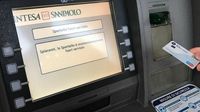On April 16, 2025, customers of Intesa Sanpaolo faced significant disruptions when they attempted to make payments and withdrawals, leading to widespread panic. Many reported seeing unauthorized deductions of 1,000 euros from their accounts, a situation reminiscent of similar issues experienced just a few weeks prior.
Throughout the morning, numerous customers found themselves unable to complete transactions at point-of-sale systems or ATMs. In some cases, they were met with messages indicating a "non-recorded" deduction of 1,000 euros. This alarming notification caused considerable concern among users, who feared that their accounts had been compromised.
According to reports from various sources, including Open and Pozzuoli News 24, the issue was attributed to a temporary IT glitch that resulted in erroneous notifications being sent to clients. Intesa Sanpaolo clarified that these messages were automatic and did not reflect actual withdrawals. The bank reassured its customers that there was no real loss of funds, stating that the notifications were merely a result of a "blocking" message that would disappear shortly.
"The phantom withdrawal of 1,000 euros is just an automatic message indicating a block and does not correspond to a real charge," the bank explained. This confusion was similar to an incident that occurred at the end of February 2025, where customers faced the same issue of phantom withdrawals.
During the disruption, which lasted from approximately 8:55 AM to 10:45 AM, some clients managed to withdraw cash on their second attempt, while others were completely unable to access their funds. The peak of customer complaints was documented by Downdetector, highlighting the widespread nature of the problem.
"If you withdraw cash from an ATM, it empties the account up to 1,000 euros," one concerned customer wrote, illustrating the level of anxiety felt by many during this period. However, the bank assured customers that there were no actual transactions taking place, and the erroneous messages were quickly rectified.
By around 10:50 AM, the situation had calmed down as the false deductions vanished from account statements, restoring the correct balances. The bank's swift response helped alleviate fears, and users were able to resume their normal banking activities shortly thereafter.
This incident has raised questions about the reliability of digital banking systems, especially as more customers rely on mobile applications for their financial transactions. With the increasing frequency of such glitches, customers are left wondering about the security of their funds and the efficiency of customer service responses.
In light of the April 16 incident and the earlier episode in February, experts are urging financial institutions to enhance their IT infrastructure to prevent similar occurrences in the future. The importance of transparent communication with customers during such crises is also emphasized, as it can significantly reduce panic and confusion.
As digital banking continues to evolve, the expectation for robust systems that can handle high volumes of transactions without error becomes paramount. Customers are advised to remain vigilant and report any discrepancies they notice in their accounts promptly.
In summary, while the April 16 disruptions at Intesa Sanpaolo caused temporary distress among customers, the bank has confirmed that no actual funds were lost, and the incident was due to a technical error rather than any form of fraud. As banking technology advances, both institutions and customers must adapt to ensure the safety and security of financial transactions.








